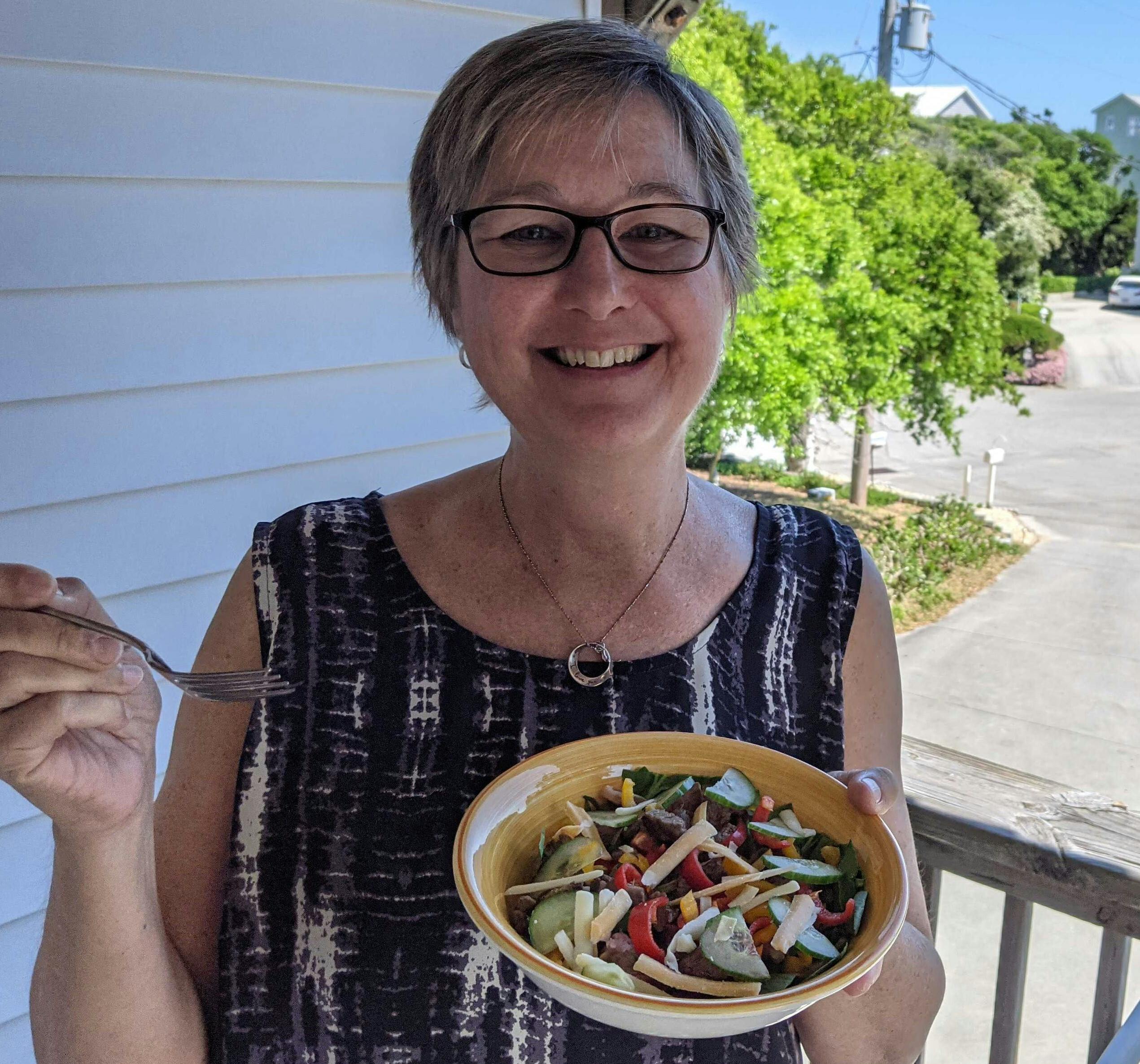Diet Doctor team tries higher protein

What happens when you eat higher protein on a low-carb diet?
Over the last three months, a number of us at Diet Doctor have been experimenting to find out.
If you’ve been considering adding more protein to your low-carb diet, you might be interested to learn from our experiences and results.
But first, why explore eating more protein on your low-carb or keto diet?
In short: It may help you lose more weight, break a weight-loss stall, or maintain or build lean muscle while reducing your body fat.“It’s clear, both in the research science and clinical experience, that by targeting foods that are high in protein, you end up meeting your essential nutrient needs and feeling full while eating less energy, which may help you lose more weight,” says Dr. Andreas Eenfeldt, CEO and founder of Diet Doctor.
Easily getting leaner
Andreas is a case in point. As a tall (6’7″), fit, and healthy, 49-year-old man, Andreas didn’t look like he had much weight to lose. He has been eating a low-carb, high-fat diet since 2002 — and has always experienced excellent health and energy.
However, since early January, he has been experimenting with cutting back on the extra fat and adding more protein.
Andreas always eats lots of vegetables and high-quality animal products like meat, seafood, and eggs. But he’s been reducing the amount of fat from nuts, cheese, and dairy products and consciously eating more high-protein foods such as chicken and salmon.
Then, he’s added in egg whites, low-fat plain Greek yogurt, shrimp, and occasionally whey protein smoothies.
Now his caloric intake is about 45% protein, 38% fat, and 17% carbs. This translates into a daily intake of about 240 grams of protein, 90 grams of fat, and 90 grams of net carbs. This is no longer a keto diet, but is considered a “liberal low-carb diet.”
For him, this higher protein focus has resulted in an effortless 10-pound weight loss, 3 inches off his waist, and his lowest-ever fasting insulin and body fat.“Initially, I had some issues with significantly more hunger and a greater need to snack, but now I’m pretty much back to two meals a day, sometimes with one snack. I’m rarely hungry between meals,” Andreas says. “So far, it is quite successful and enjoyable for me.”
He is going to see if he can get below 10% body fat without too much effort. However, he may return to a slightly higher fat, lower carb diet in the future “for enjoyment, satiety, and long-term effectiveness.”
Hello egg whites
Dr. Bret Scher, our medical director, has also been experimenting with higher protein since early January.




Bret notes that he was never one to throw on lots of extra fat. “I always ate the fat that came with whole foods like chicken and beef, and I always cooked in butter or added olive oil to my salad, but I never did fat bombs or buttered coffee or extra sour cream or mayonnaise.”
Bret’s low-carb diet, too, was always higher protein “at least compared to the Standard American Diet.” He estimates that previously his low-carb diet was 25% protein, but now he aims to make it about 35% protein.
“The big change for me is reducing my nuts and cheese. I used to put nuts and cheese on everything! My snacks were always nuts and cheese, too,” he says.Bret is also increasing his consumption of egg whites. For example, he used to eat three eggs each morning with leftover vegetables from the night before. Now he still eats the veggies, but he adds “one egg and a bunch of egg whites.” In his picture here, he’s eating a scramble of one egg, three egg whites, some cottage cheese, and sardines on a bed of left-over vegetables and edamame noodles.
Always fit and trim, Bret notices that he has “lost a bit of weight and body fat” with almost no effort. “Nothing huge, but it is noticeable on my scale.”
Other men in the company, such as our COO Bjarte Bakke, have also found that adding higher protein to their low-carb diet has resulted in seemingly effortless weight loss and reduced body fat.
Higher protein for years
Registered dietitian and senior writer Adele Hite, PhD is delighted that the company is putting more focus on protein. She’s been advocating that low-carbers eat more protein since she joined the team in 2019, something she has been doing in her low-carb diet for more than 15 years.








In the mid-2000s, Adele was a health coach in Dr. Eric Westman’s low-carb clinic in North Carolina, USA. She recalls many patients, especially middle-aged and menopausal women, would come to the clinic with very slow metabolisms from years of dieting. Most had under-eaten protein for decades.
No matter what their actual weight or BMI, most of the women had a high body fat percentage and very low lean muscle mass, a condition called “sarcopenic obesity.”
A low-carb diet might help them lose some weight, but many would eventually stall or still have an unhealthy body composition. The key to improving their metabolism and health was getting them to eat more protein, well above the US Recommended Daily Allowance (RDA) of 0.8 grams of protein per kilogram of ideal body weight.
Diet Doctor now recommends that, to start, you aim for at least 1.2 grams to 2.0 grams of protein per kilogram of ideal body weight. Depending on your personal goals, you may decide over time to go even higher.
Adele calls that a protein-focused low-carb diet. “That range might be higher relative to the RDA, but it isn’t higher relative to what your body needs to build muscle, bones, skin, hair, and all the rest.”
Adele puts protein first, getting enough at the start of her day, and making it the centerpiece of every meal. She aims for about 35 grams of protein at every meal.“I start my day with my special “protein yogurt”— a mix of higher protein, low-sugar vanilla yogurt plus a heaping tablespoon of vanilla-flavored, whey protein powder [sweetened with stevia], and a few big dollops of high fat, plain yogurt. It’s yummy and about 35 grams of protein.”
Lunch is typically leftovers from dinner — a favorite is sliced steak on a salad. That’s what she is eating in her picture here. Then dinner is meat and two veggies, in various recipes.
In all, Adele gets about 110 to 120 grams of protein a day. She is getting about 30% protein, 60% fat, and 10% net carbs in total.
“I rarely snack. I’m just not hungry between meals. If I am, it’s probably because I didn’t prioritize protein earlier in the day,” Adele says.
Three eggs or sardines on kale
Our other senior dietitian and writer, Franziska Spritzler, has also been consuming a higher protein, low-carb diet since 2011. Like Adele, ever since Franziska joined Diet Doctor in 2019, she has been encouraging the company to feature recipes and options for higher protein meals to increase the weight loss success of those following a low-carb diet.




Franziska eats about 35% of her daily calories as protein, or about 110 to 125 grams of protein a day, which translates into her consuming about 2.0 to 2.2 grams per kilogram of her body weight.
What does that look like in her daily meals?
For breakfast, Franzkiska often eats three eggs or a can of sardines atop a bed of sauteed kale, as shown in her picture. Alongside that, she will eat for breakfast a cup of plain low-fat Greek yogurt with chopped walnuts, ground flax seeds, and erythritol.
Lunch is typically 4 to 5 ounces of chicken or salmon with avocado and arugula and one-half cup of cottage cheese with berries.
Dinner is usually about 6 ounces of chicken along with vegetables, such as Diet Doctor’s yummy mushroom and ricotta stuffed chicken breast . She often finishes dinner off with a piece of dark chocolate.
What is her top tip for newbies? “Increase your protein slowly. Add one extra egg at a time. Add just an extra ounce of meat, poultry, or fish at first before trying to add more.”Not easy for all
Many of the company’s protein experimenters — especially the women — have been surprised to learn that they were undereating protein for years.
Crystal Pullen, a moderator in the Diet Doctor Facebook group and a member of the community support team, was always successful on a keto diet. However, increasing her protein macros over the last nine weeks has resulted in another 10 pounds in weight loss and 2 inches off her waist.




“Hunger was an issue the first few days as I tried to figure things out. Tracking is annoying and time-consuming, but it helps to see where I need more protein,” Crystal says. “I’ve come to learn that my usual serving of meat was only 3 to 4 ounces which is far from the 6 to 7 ounces that I need. It has been a huge learning experience.”
Others have found experimenting with higher protein to be challenging at first, but success has come with time.
Popular recipe creator and low-carb personality Kristie Sullivan is one who has found the experiment challenging but ultimately rewarding.
When Kristie discovered the low-carb, high-fat keto diet in 2013, she lost more than 100 pounds. After a life-long struggle with her weight, she loved the easy, sustainable way keto made her feel around food. She’s now written five low-carb and keto cookbooks, has a large following, and is a key recipe creator for Diet Doctor.




She was at first reluctant to add in more protein and reduce the fat. She worried about her blood glucose rising, potential insulin spikes, weight gain, and a return to her struggle with food.
However, she had noticed that after her long-term keto success, in recent years, the pounds were slowly creeping on again — without changing anything about her formerly successful keto meals.
She decided to put aside her fears to see if upping protein could help her lose weight again. She started in early March.
“In the first few weeks, I lost a good amount of weight and was encouraged. And then I got really hungry. I seemed to wake up hungry, and the hunger lasted all day.”
Along with the hunger, Kristie found that she had to count, measure, and track her food to ensure she was eating enough protein. “It was very eye-opening how much fat and how little protein I was eating.” However, the tracking brought memories of past dieting attempts and feelings of failure.
“Hunger and tracking make it feel like a diet and can trigger bad choices or binges for me,” Kristie says.
Kristie tried to deal with her feelings of hunger by slightly increasing the fat, but then her weight loss stalled.
Recently, instead of upping the fat, she has tried to feed the hunger by eating a high-protein snack. It means she was eating more frequently, with more snacks and meals, than her usual high-fat keto diet. All this scared her.
But now, feeding her hunger with more protein has worked! The hunger stopped at about seven weeks. And even more amazing to her is that her desire for sweets has totally left her.
She started losing weight again in early April and the hunger pangs finally stopped. She has now lost 19 pounds and it appears her weight-loss is continuing. Her waist is a few inches smaller, and her clothes fit better. She is pleased.
“It has taken some work, but now I’m at peace with the food scale and the bodyweight scale. I am no longer feeling deprived or restricted. Now I can easily eat only two meals a day again and I can wait later in the day to eat.”
Kristie is busy creating higher protein recipes for Diet Doctor. “Fat really does add flavor, so a higher protein meal can sometimes need more seasoning,” she says.
She’s making some great tasty high-protein dessert recipes, too, such as the raspberry souffle dessert she holds in her picture. And she’ll keep evaluating her protein experiment in the months ahead.
Do migraines return with more protein?
I, too, have been experimenting with higher protein since January. Like others, when I discovered the low-carb, high-fat keto diet in 2015, it was a health revelation. Adopting the keto diet enabled me to drop about 10 pounds. I rapidly improved my prediabetes and normalized my blood sugar.
Other symptoms improved with keto eating, too. My IBS calmed, my skin became more supple, and any cravings for sugar and carbs disappeared. Another huge benefit? Improved mental clarity and a complete halt to the migraines I used to get every couple of months.
Like Bret, I was never one to add lots of fat to my meals. I never ate fatbombs or drank buttered coffee. But I started focusing on eating higher protein in January, going from about 20 to 35% protein in my low-carb diet, and like Adele and Franziska, I aimed for 35 grams at every meal. I mostly cut out nuts, reduced cheese, and upped my consumption of eggs, Greek yogurt, and tuna. I increased the size of my meat servings and added in a whey protein smoothie a few times a week.
In a few weeks, I dropped a few more pounds, and I was pleasantly surprised that without much effort, my body fat percentage finally got below 25%. (On the keto diet, it reduced from 33% but stayed stuck at 28% for years.) My gut remained calm.
But then, in mid-March, 10 weeks into the experiment, I got my first migraine in five years.Was it adding more protein and reducing fat? Was it the stress of Covid-19 that is surging in my country? The change of season? Am I sensitive to whey protein isolate? I don’t yet know. I do know that, at the time, I had slept poorly and was reacting badly to tree pollen allergies. These in the past were also migraine triggers for me.
I am going to keep an eye on the migraine issue. Perhaps, having slightly more fat is better for me, or cutting out any whey protein. I may aim for somewhere between 25 to 30% protein.
Others on the team have struggled, too. Kristin Parker, who works as moderator and in customer support, has upped her protein but had no weight loss and is trying to sort it all out with medical support.
What is the right level of protein and fat for you? You may have to experiment with various levels to find out. Each of us is unique.
As Andreas Eenfeldt notes, Diet Doctor’s mission is to empower people everywhere to dramatically improve their health. So use our resources and our thousands of recipes to find the right amount of protein for you to get the best results. It may take a bit of time and personal tweaking.
And let us know how you do.